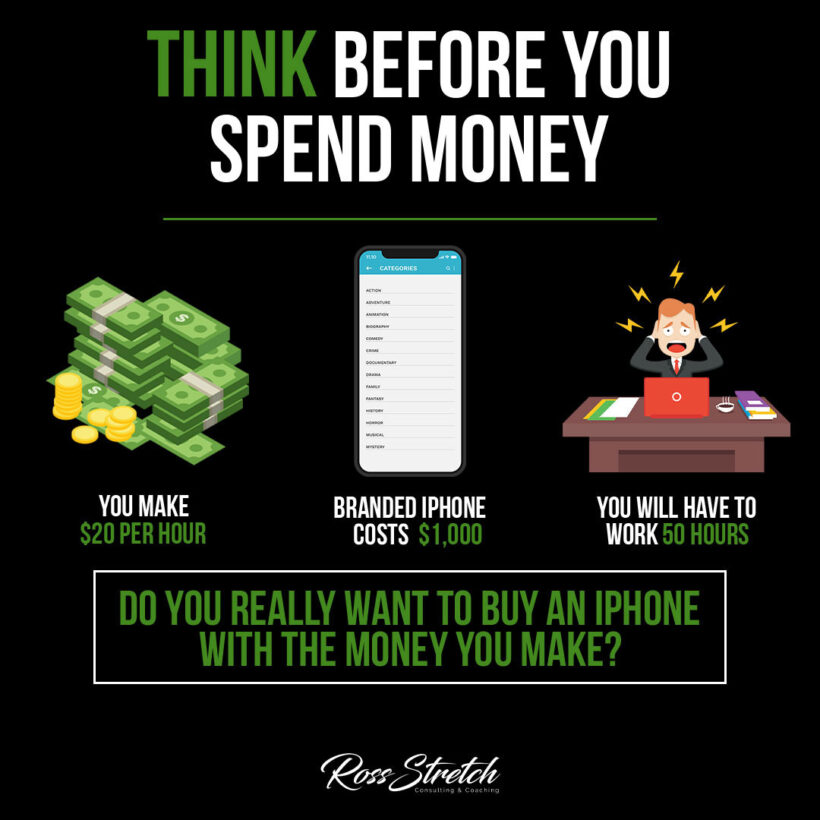In today’s consumer-driven world, it’s easy to buy things on impulse, especially when credit cards and digital wallets make spending so convenient. However, every purchase represents more than a dollar amount—it represents the time and effort you invested to earn that money. By thinking before spending, you can make more informed financial decisions that better align with your goals and values. Here’s a guide on how to evaluate purchases in terms of time, prioritize needs over wants, and cultivate mindful spending habits.
1. Calculate Purchases in Terms of Work Hours
A great way to evaluate any potential purchase is by calculating how many hours of work it would take to pay for it. For instance, if you earn $20 per hour and an item costs $1,000, it requires 50 hours of work to afford it. Seeing expenses in this context helps you consider whether the purchase is truly worth the time and effort.
- Benefits of Evaluating by Work Hours:
- Creates a Reality Check: When you translate the cost of items into work hours, you get a clearer sense of the time investment required.
- Discourages Impulse Purchases: This method can curb impulsive spending by making you consider whether an item is worth your time.
- Promotes Financial Awareness: Calculating in work hours helps reinforce the value of your hard-earned money.
For example, thinking about an iPhone that costs 50 hours of labor can make you reconsider the purchase or look for more affordable alternatives.
2. Differentiate Between Needs and Wants
Understanding the difference between needs and wants is fundamental to mindful spending. Needs are essential items, like food, housing, and basic clothing, while wants are items that enhance comfort or pleasure, such as the latest gadgets, designer clothes, or dining out.
- Strategies for Prioritizing Needs:
- List Essentials First: Identify essential expenses and allocate a portion of your budget to cover these first.
- Define Personal Values: Consider what brings lasting value to your life versus temporary satisfaction.
- Delay Gratification: If you desire a non-essential item, wait for a few days to see if you still feel the same urge to buy it.
This prioritization can help you save money for future goals rather than spending on items that offer only short-term satisfaction.
3. Adopt the 24-Hour Rule for Large Purchases
When you’re considering a significant purchase, adopting the 24-hour rule can help prevent impulsive decisions. This rule involves waiting at least 24 hours before making a non-essential purchase, giving you time to think through the benefits, downsides, and alternative options.
- Why the 24-Hour Rule Works:
- Reduces Impulse Buying: Waiting allows you to step back and evaluate whether the item truly aligns with your goals.
- Encourages Budget-Friendly Alternatives: The extra time can reveal more affordable or practical options.
- Boosts Satisfaction: When you finally decide to buy, you’ll feel more satisfied with a well-thought-out choice.
The 24-hour rule is particularly effective for items over a certain amount, like electronics, furniture, or luxury clothing.
4. Consider Opportunity Cost
Opportunity cost is the concept of what you forego by choosing one option over another. Every dollar spent on one purchase is a dollar that can’t be used elsewhere, like saving for an emergency fund, investing, or a future experience.
- Applying Opportunity Cost in Spending Decisions:
- Think Long-Term: Consider how the purchase will impact your finances in the future.
- Reflect on Alternative Uses: Ask yourself what other ways you could use the money and whether those alternatives bring more value.
- Assess Personal Goals: Align your spending with your financial and personal goals, such as saving for retirement, travel, or education.
Understanding opportunity cost can help you view money as a resource to achieve goals rather than a means to satisfy short-term desires.
5. Practice Delayed Gratification
Delayed gratification is the practice of resisting the urge to buy immediately in favor of a future reward. Training yourself to wait helps build financial discipline and often leads to greater satisfaction with purchases.
- Ways to Practice Delayed Gratification:
- Set Saving Goals: Put money aside for larger purchases instead of using credit, which can prevent debt and interest fees.
- Create a Wishlist: Instead of buying immediately, add desired items to a wishlist and revisit after a set period.
- Celebrate Achievements: When you finally make a well-considered purchase, it feels more rewarding, knowing you waited and planned for it.
By practicing delayed gratification, you’re not only saving money but also appreciating the purchases that you do eventually make.
6. Reflect on Past Purchases
One of the best ways to improve future spending is by reflecting on past purchases. Looking back on things you’ve bought can provide valuable insights into your spending habits, helping you identify patterns and areas for improvement.
- Reflection Techniques:
- Keep a Spending Journal: Track your purchases and review them monthly to identify unnecessary expenses.
- Ask Key Questions: Reflect on questions like, “Did this purchase bring lasting value?” or “Would I buy this item again?”
- Analyze Common Themes: Recognize if there’s a specific category where you overspend, such as dining out or gadgets, and make adjustments accordingly.
Reviewing past purchases can highlight where you can cut back and where money is better spent, helping you become a more mindful consumer.
Conclusion
Thinking before you spend is a powerful practice that leads to financial wellness, satisfaction, and the achievement of long-term goals. By evaluating purchases in terms of work hours, distinguishing between needs and wants, and practicing delayed gratification, you can make informed decisions that align with your values and priorities. Each mindful decision brings you closer to a healthier financial future, freeing up resources for what truly matters in your life.


